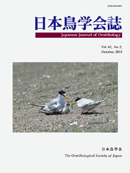Volume 62, Issue 2
Displaying 1-11 of 11 articles from this issue
- |<
- <
- 1
- >
- >|
ARTICLES
-
2013Volume 62Issue 2 Pages 135-142
Published: 2013
Released on J-STAGE: November 21, 2013
Download PDF (1036K) -
2013Volume 62Issue 2 Pages 143-152
Published: 2013
Released on J-STAGE: November 21, 2013
Download PDF (1249K) -
2013Volume 62Issue 2 Pages 153-165
Published: 2013
Released on J-STAGE: November 21, 2013
Download PDF (1219K)
SHORT NOTES
-
2013Volume 62Issue 2 Pages 166-170
Published: 2013
Released on J-STAGE: November 21, 2013
Download PDF (861K)
OBSERVATIONAL DATA
-
2013Volume 62Issue 2 Pages 171-174
Published: 2013
Released on J-STAGE: November 21, 2013
Download PDF (970K) -
2013Volume 62Issue 2 Pages 175-178
Published: 2013
Released on J-STAGE: November 21, 2013
Download PDF (929K) -
2013Volume 62Issue 2 Pages 179-183
Published: 2013
Released on J-STAGE: November 21, 2013
Download PDF (1075K) -
2013Volume 62Issue 2 Pages 184-188
Published: 2013
Released on J-STAGE: November 21, 2013
Download PDF (1390K) -
2013Volume 62Issue 2 Pages 189-191
Published: 2013
Released on J-STAGE: November 21, 2013
Download PDF (1023K) -
2013Volume 62Issue 2 Pages 192-194
Published: 2013
Released on J-STAGE: November 21, 2013
Download PDF (994K) -
2013Volume 62Issue 2 Pages 195-198
Published: 2013
Released on J-STAGE: November 21, 2013
Download PDF (1109K)
- |<
- <
- 1
- >
- >|
